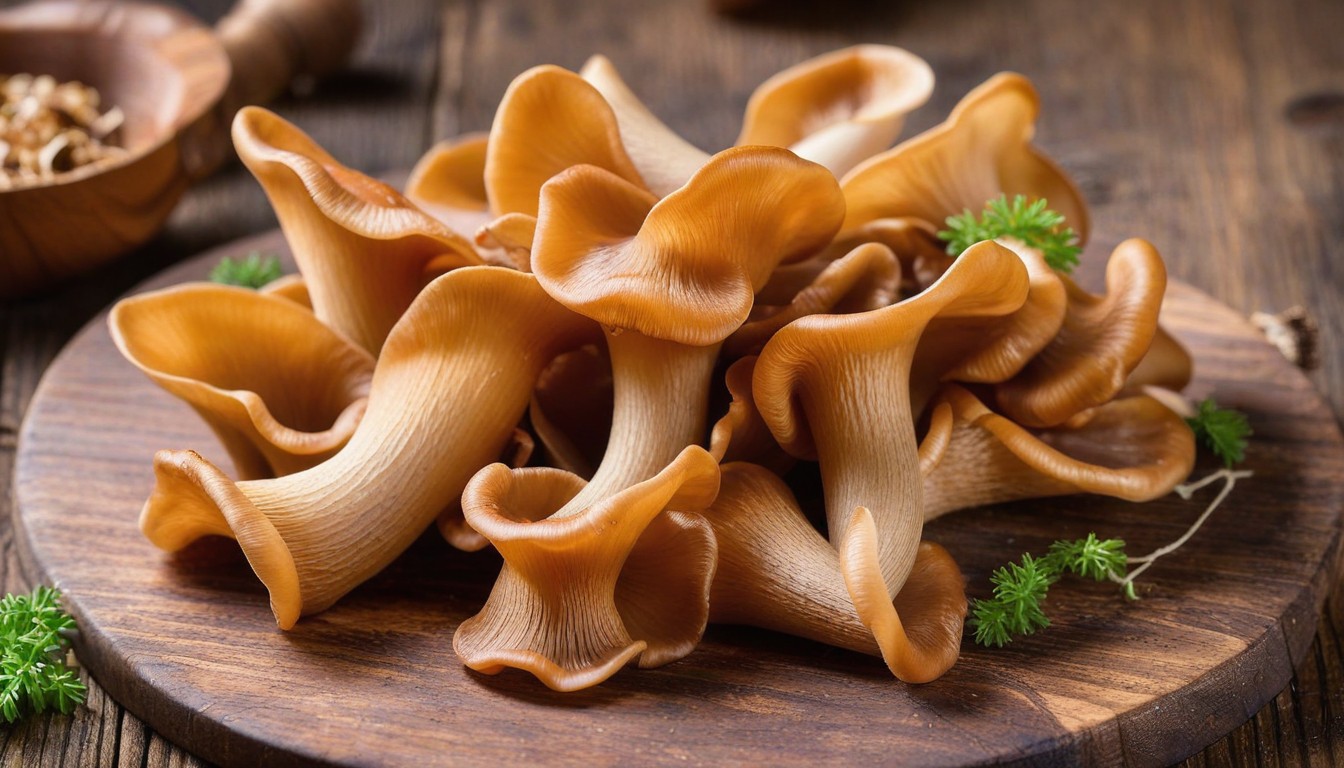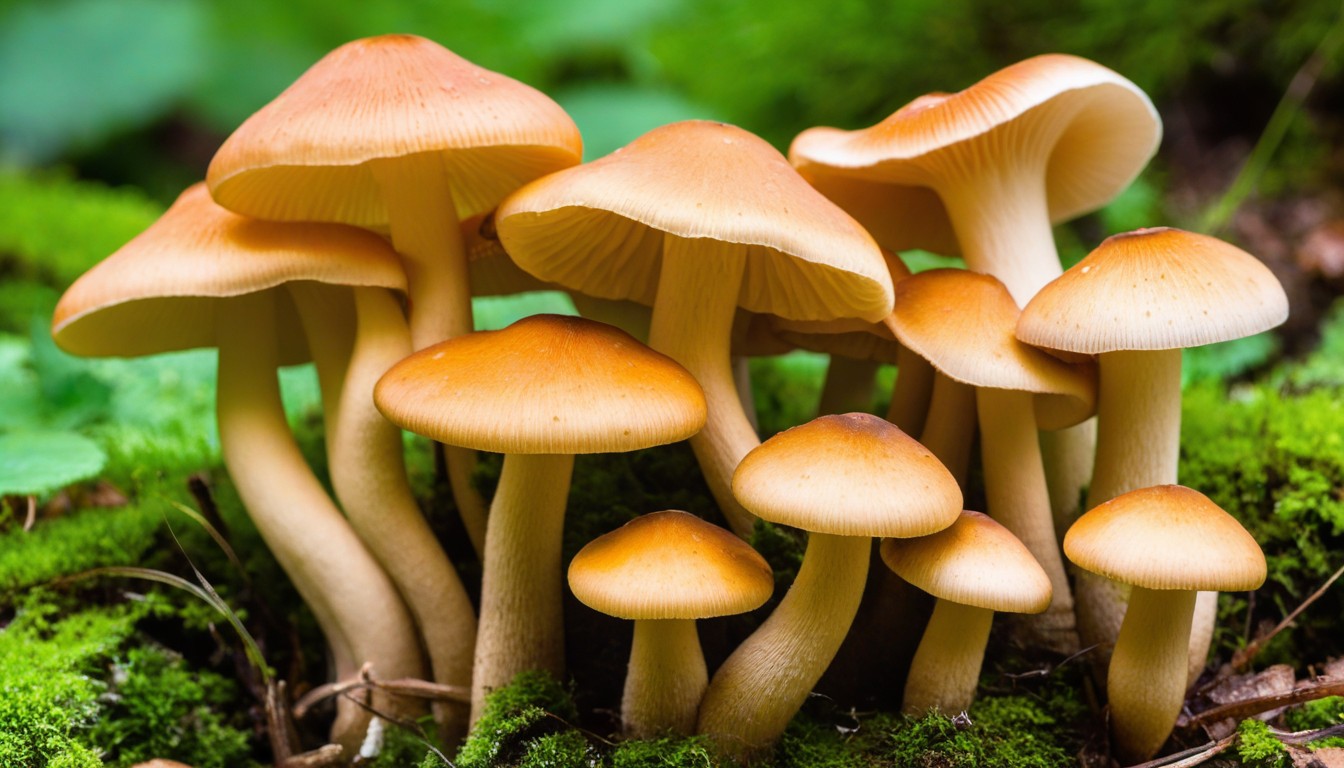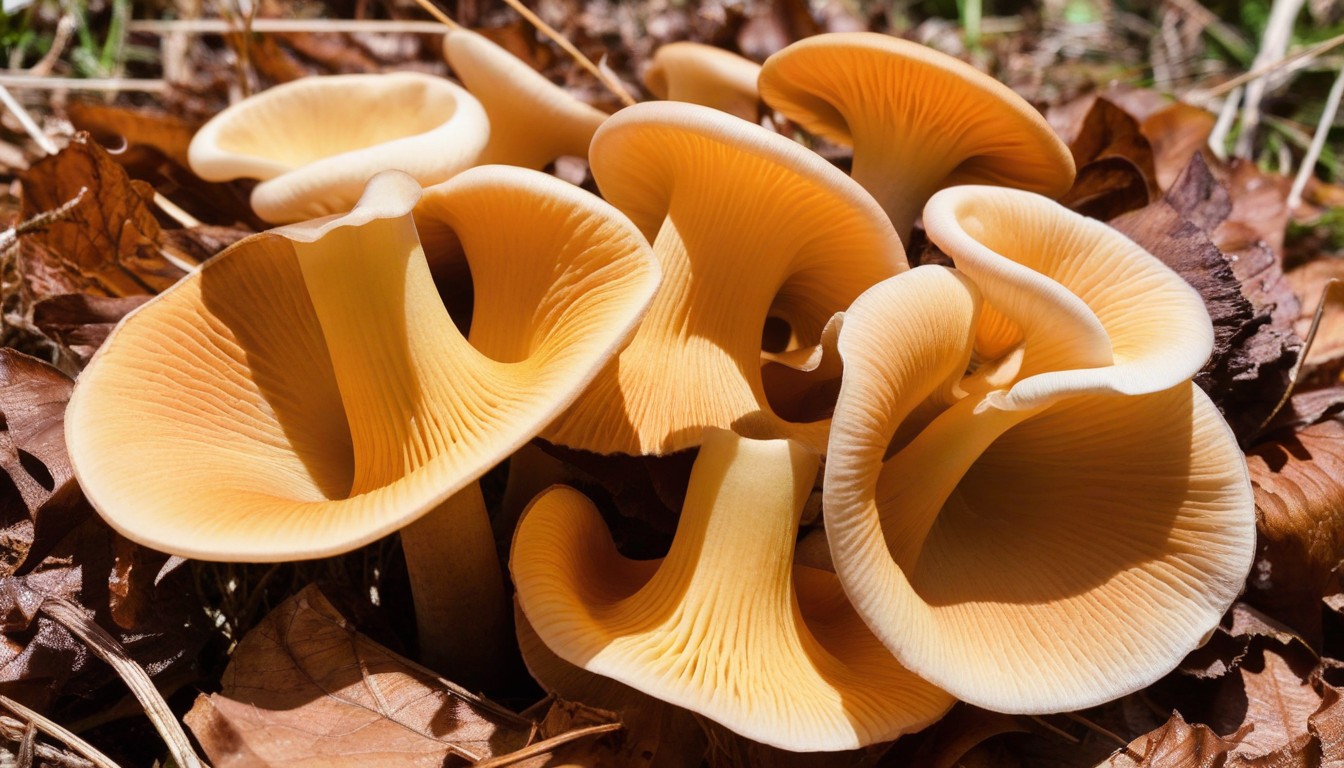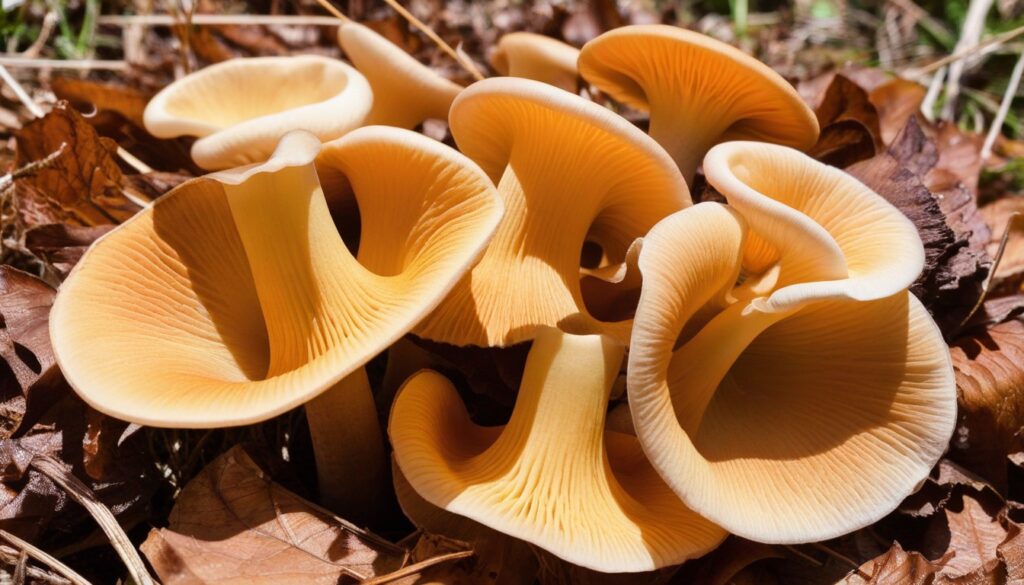In this comprehensive guide, we will explore the world of Pigs Ear Mushrooms, including their health benefits and delicious ways to incorporate them into your meals. Whether you’re a seasoned cook or just starting, this guide will provide you with everything you need to know to make the most of this unique fungus.
Key Takeaways:
- Learn about the unique characteristics and flavor profile of Pigs Ear Mushrooms
- Discover the incredible health benefits that Pigs Ear Mushrooms offer, from boosting your immune system to providing valuable nutrition
- Explore various cooking methods and techniques for preparing Pigs Ear Mushrooms and how to enhance their flavors
- Get access to a collection of delectable recipes that showcase the versatility of Pigs Ear Mushrooms
- Understand the potential risks associated with consuming Pigs Ear Mushrooms and how to properly handle them to ensure safety
What are Pigs Ear Mushrooms?
Pigs Ear Mushrooms are a unique and fascinating type of fungi that are increasingly popular in the culinary world. These mushrooms have an interesting appearance, typically sporting a reddish-brown color and a wavy, fan-like shape that somewhat resembles a pig’s ear.
Beyond their intriguing look, Pigs Ear Mushrooms are also known for their subtle, earthy flavor, making them a versatile ingredient in a variety of dishes.
If you’re curious about where to find Pigs Ear Mushrooms, they tend to grow in clusters on dead hardwood trees or fallen logs in temperate forests.
Overall, Pigs Ear Mushrooms are a fantastic addition to any meal, adding unique flavor and texture to a range of dishes.
The Health Benefits of Pigs Ear Mushrooms
Pigs Ear Mushrooms aren’t just a tasty addition to your meals; they also provide numerous health benefits that can improve your overall well-being. These mushrooms are low in calories, fat-free, and contain an abundance of vitamins and minerals.
Immune-Boosting Properties
Pigs Ear Mushrooms contain beta-D-glucans, a type of polysaccharide that stimulates the immune system’s white blood cells. Research has shown that consuming these mushrooms regularly can help enhance your body’s defense against infections.
Anti-Inflammatory Properties
The high levels of antioxidants and polysaccharides found in Pigs Ear Mushrooms make them a potent anti-inflammatory agent. Inflammation can be a leading cause of various chronic illnesses; however, consuming these mushrooms can help reduce the risk of developing such conditions.
Lowering Cholesterol
The beta-glucans found in Pigs Ear Mushrooms help to regulate cholesterol levels in the body, reducing the risk of developing heart diseases. These mushrooms also help to decrease the absorption of cholesterol from the food we consume.
Improving Brain Function
Pigs Ear Mushrooms contain ergothioneine, an antioxidant that helps to protect the brain from oxidative stress. Studies have also shown that ergothioneine can improve neurological function and cognitive abilities.
Nutritional Value
Pigs Ear Mushrooms are a rich source of essential minerals such as potassium, calcium, and iron. They are also an excellent source of dietary fiber, which aids in digestion. These nutrient-dense mushrooms are a great addition to any diet.
Cooking with Pigs Ear Mushrooms: Tips and Techniques

When it comes to cooking Pigs Ear Mushrooms, there are several methods and techniques to enhance their flavors and textures. One easy way to enjoy their earthy taste is by sautéing them in garlic butter and olive oil. Another popular approach is incorporating them into stir-fries and soups, adding depth and richness to your dishes.
For a more sophisticated dish, try roasting Pigs Ear Mushrooms with thyme and garlic, serving them with grilled steak or roasted chicken. The mushrooms’ unique texture can also be used as a meat substitute in vegetarian or vegan recipes, such as mushroom burgers, tacos, and burritos.
When working with Pigs Ear Mushrooms, it’s essential to prepare them properly to ensure a safe and enjoyable culinary experience. Here are some helpful tips to get you started:
- Remove any dirt or debris by gently wiping them with a damp cloth or using a soft-bristled brush. Avoid washing them with water, as they can become soggy and lose their flavor.
- Trim the stem ends and cut them into uniform pieces to ensure even cooking.
- Experiment with different flavor profiles by combining Pigs Ear Mushrooms with other herbs, spices, and seasonings, such as soy sauce, ginger, or lemon juice.
Overall, cooking with Pigs Ear Mushrooms is an enjoyable and creative experience, offering a vast range of culinary possibilities. With these tips and techniques, you’ll be able to bring out the best in these wonderful fungi and create mouthwatering dishes that everyone will enjoy.
Tasty Recipes Featuring Pigs Ear Mushrooms

Are you ready to try some new, tasty recipes featuring Pigs Ear Mushrooms? Look no further! This versatile fungi can be enjoyed in a variety of dishes, adding unique flavors and textures to your meals.
Pigs Ear Mushroom Stir-fry
Add a twist to your typical stir-fry by incorporating Pigs Ear Mushrooms. Heat a tablespoon of oil in a wok or skillet and stir-fry garlic and sliced Pigs Ear Mushrooms for a few minutes until tender. Add your favorite veggies and protein, such as broccoli and tofu, and continue stir-frying until everything is cooked to your liking. Serve over rice for a complete meal.
Pigs Ear Mushroom Pasta
Elevate your pasta game with Pigs Ear Mushrooms. Cook your desired pasta according to the package instructions. In a separate pan, sauté garlic, shallots, and sliced Pigs Ear Mushrooms in olive oil until tender. Add heavy cream and grated Parmesan cheese, stirring until the sauce thickens. Combine the sauce with the pasta, sprinkle some fresh parsley on top, and enjoy!
Pigs Ear Mushroom Soup
Warm up with a bowl of Pigs Ear Mushroom soup. In a large pot, sauté chopped onion and garlic until fragrant. Add sliced Pigs Ear Mushrooms, vegetable broth, and your desired seasonings, such as thyme and bay leaves. Allow the soup to simmer until the mushrooms are tender. Serve hot with a side of crusty bread.
|
Recipe |
Ingredients |
Instructions |
|---|---|---|
|
Pigs Ear Mushroom Stir-fry |
Garlic, sliced Pigs Ear Mushrooms, veggies (broccoli, bell peppers, snow peas), protein (tofu, chicken, shrimp), oil, rice |
Stir-fry garlic, sliced Pigs Ear Mushrooms, veggies, and protein in oil. Serve over rice. |
|
Pigs Ear Mushroom Pasta |
Garlic, shallots, sliced Pigs Ear Mushrooms, olive oil, heavy cream, Parmesan cheese, pasta, parsley |
Sauté garlic, shallots, and sliced Pigs Ear Mushrooms. Add heavy cream and Parmesan cheese. Combine with pasta and serve with parsley on top. |
|
Pigs Ear Mushroom Soup |
Onion, garlic, sliced Pigs Ear Mushrooms, vegetable broth, thyme, bay leaves, bread |
Sauté onion and garlic. Add sliced Pigs Ear Mushrooms, vegetable broth, and seasonings. Simmer until tender. Serve with bread. |
Get creative with your cooking and experiment with other delicious recipes featuring Pigs Ear Mushrooms. From soups and stews to pizza toppings and more, the possibilities are endless!
Pigs Ear Mushroom Risks and Precautions

While Pigs Ear Mushrooms offer many health benefits, there are certain risks associated with consuming these fungi. Some people may experience an allergic reaction or adverse side effects, such as diarrhea or stomach discomfort. It’s important to take precautions when handling and preparing Pigs Ear Mushrooms to minimize any potential risks.
Identifying Pigs Ear Mushrooms
Identifying Pigs Ear Mushrooms can be tricky since they can easily be confused with other types of fungi. Make sure to do your research and seek out reputable sources when foraging for Pigs Ear Mushrooms in the wild. Look for mushrooms with a wavy, ear-like shape that grow on dead or decaying wood. They are typically brown or reddish-brown in color and have a soft, velvety texture.
Handling and Cleaning Pigs Ear Mushrooms
When handling Pigs Ear Mushrooms, wear gloves to prevent any potential skin irritation or allergic reactions. Before cooking, clean the mushrooms thoroughly by gently wiping them with a damp towel or rinsing them under running water. Avoid soaking Pigs Ear Mushrooms since they can absorb too much water and become soggy when cooked.
Cooking Pigs Ear Mushrooms
Before consuming Pigs Ear Mushrooms, make sure they are cooked thoroughly to reduce any potential harmful bacteria or parasites. Avoid eating them raw or undercooked. Also, be mindful of the portion size and frequency of consumption. While Pigs Ear Mushrooms offer many health benefits, consuming too many can overload the body with certain nutrients and minerals.
The Culinary and Cultural Significance of Pigs Ear Mushrooms

Pigs Ear Mushrooms have a rich culinary history that spans many cultures. In Chinese cuisine, they are known as “mu er” and are a popular ingredient in soups, stews, and side dishes. The Japanese use them in salads, and in Korean cuisine, they are often pickled as a side dish. In Western cuisine, Pigs Ear Mushrooms are used as a flavorful ingredient in pasta dishes, stir-fries, and risottos.
Aside from their mouthwatering flavor, Pigs Ear Mushrooms also hold cultural significance. In Chinese folklore, the mushroom is believed to have healing properties and was used by Taoist monks for medicinal purposes. The mushroom’s unique appearance also makes it a popular decorative element in traditional Chinese art and pottery.
“Pigs Ear Mushrooms are a versatile ingredient that adds depth and complexity to many dishes.”
In addition to their traditional uses, Pigs Ear Mushrooms are also gaining popularity for their potential health benefits. With their high fiber content and anti-inflammatory properties, they are believed to improve gut health and boost the immune system.
|
Country |
Cuisine |
Traditional Dish |
|---|---|---|
|
China |
Chinese |
Hot and sour soup with Pigs Ear Mushrooms |
|
Japan |
Japanese |
Ponzu sauce salad with Pigs Ear Mushrooms |
|
South Korea |
Korean |
Whether you are a seasoned chef or just starting in the kitchen, Pigs Ear Mushrooms are a versatile ingredient that adds depth and complexity to many dishes. With their culinary and cultural significance, they are sure to impress your guests and elevate your cooking to the next level.
Grow Your Own Pigs Ear Mushrooms: Tips and Techniques
If you want to enjoy the unique flavors and nutritional benefits of Pigs Ear Mushrooms right from your backyard, learning how to grow them at home is the way to go. Here are some tips and techniques to get you started:
Step 1: Choose the right location
Select a location with partial or filtered sunlight, since Pigs Ear Mushrooms prefer shady spots. Also, ensure the site is rich in organic matter, which is critical to mushrooms’ growth and development.
Step 2: Gather the necessary materials
You need mushroom spawn, compost, straw, a spray bottle, and a container for your setup. Mushroom spawn is readily available from organic gardening centers and online suppliers.
Step 3: Prepare the substrate
In a clean container, mix compost and straw in a 1:1 ratio to make the substrate. Add enough water to make it moist, but not over-saturated. Sprinkle the mushroom spawn on the substrate and mix well.
Step 4: Allow the mushrooms to grow
Cover the container with a lid or plastic wrap with small holes for ventilation. Keep the setup in a cool, dark place, periodically adding water to keep the substrate moist. Within a few weeks, you should see mushrooms sprouting through the substrate.
Step 5: Harvest your Pigs Ear Mushrooms
When the mushrooms reach the desired size, typically 1-2 inches in diameter, use a sharp knife to cut them off the substrate. Avoid pulling them off, as this may damage and contaminate the remaining mushrooms.
By following these tips and techniques, you’ll be able to grow delicious Pigs Ear Mushrooms in the comfort of your own home.
Conclusion
Pigs Ear Mushrooms are a unique and delicious addition to any diet, offering numerous health benefits and culinary possibilities. From their immune-boosting properties to their traditional uses in various cuisines around the world, these mushrooms are worth exploring.
With the tips and techniques presented in this guide, you can confidently incorporate Pigs Ear Mushrooms into your cooking and even grow them in your own backyard. Remember to handle them with care and follow precautions to ensure your safety.
So, go ahead and experiment with Pigs Ear Mushrooms in your kitchen. You may just discover a new favorite ingredient!
FAQ
What are Pigs Ear Mushrooms?
Pigs Ear Mushrooms, also known as Aleuria aurantia, are a species of brightly colored fungi that resemble the shape of a pig’s ear. They can be found in various habitats, including woodlands and grassy areas.
What are the health benefits of Pigs Ear Mushrooms?
Pigs Ear Mushrooms offer a range of health benefits. They are rich in antioxidants, which can help boost the immune system and protect against oxidative stress. Additionally, they are a good source of dietary fiber and contain essential minerals such as potassium and magnesium.
How can I cook with Pigs Ear Mushrooms?
Pigs Ear Mushrooms are versatile and can be cooked in various ways. They can be sautéed, stir-fried, or added to soups and stews for added flavor and texture. It is important to properly clean and trim the mushrooms before cooking to ensure optimal taste and safety.
Are there any risks associated with consuming Pigs Ear Mushrooms?
While Pigs Ear Mushrooms are generally considered safe to eat, it is important to properly identify them and ensure they are not contaminated or mixed with toxic mushrooms. If you are uncertain about the mushrooms you have found, it is best to consult with a knowledgeable expert or mycologist.
How can I grow Pigs Ear Mushrooms at home?
Growing Pigs Ear Mushrooms at home requires specific techniques and resources. It is recommended to purchase a Pigs Ear Mushroom growing kit or obtain spawn from a reputable source. Creating a suitable growing environment with the right temperature, humidity, and substrate is crucial for successful cultivation.

